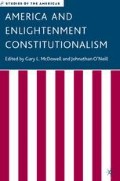Abstract
The ratification of the U.S. Constitution in 1788 was greeted with more excitement and more unanimity among the American people than at any time since the Declaration of Independence a decade earlier. “ ’Tis done!” declared Benjamin Rush in July 1788. “We have become a nation.” This was an extravagant claim, to say the least. Yet Rush thought that the new United States had become a nation virtually overnight. Everywhere in America, he said, there was “such a tide of joy as has seldom been felt in any age or country. …Justice has descended from heaven to dwell in our land, and ample restitution has at last been made to human nature by our new Constitution of all the injuries she has sustained in the old world from arbitrary government, false religions, and unlawful commerce.” The new nation represented the “triumph of knowledge over ignorance, of virtue over vice, and of liberty over slavery.”1
Access this chapter
Tax calculation will be finalised at checkout
Purchases are for personal use only
Preview
Unable to display preview. Download preview PDF.
Notes
John Adams, “Dissertation on the Feudal and Canon Law” (1765), in The Rising Glory of America, 1760–1820, ed. Gordon S. Wood (New York: Braziller, 1971), 29.
Charles S. Hyneman and George W. Carey, eds., A Second Federalist: Congress Creates a Government (Columbia, SC: University of South Carolina Press, 1967), 24.
Allen R. Pred, Urban Growth and the Circulation of Information: The United States System of Cities, 1790–1840 (Cambridge, MA: Harvard University Press, 1973), 26.
Evarts B. Greene, The Revolutionary Generation, 1763–1790 (New York: Macmillan, 1943), 418; Colin Bonwick, English Radicals and the American Revolution (Chapel Hill: University of North Carolina Press, 1977), 13–14; Alan D. McKillop, “Local Attachment and Cosmopolitanism—The Eighteenth-Century Pattern,” in From Sensibility to Romanticism: Essays Presented to Frederick A. Pottle, ed. Frederick W. Hilles and Harold Bloom (New York: Oxford University Press, 1965), 197; David Ramsay to John Eliot, August 11, 1792, in David Ramsay . . . Selections From His Writings, ed. Robert L. Burnhouse, trans. American Philosophical Society (Philadelphia: American Philosophical Society, 1965), 133.
Julie Richter, “The Impact of the Death of Governor Francis Fauquier on His Slaves and Their Families,” The Colonial Williamsburg Interpreter 18 (1997): 1–7, 2.
Joel Barlow, Advice to the Privileged Orders in the Several States of Europe (Ithaca: Cornell University Press, 1956; republished from the original 1792 edition), 17; Harry C. Payne, The Philosophes and the People (New Haven: Yale University Press, 1976), 7–17.
Virginia Ratifying Convention, in The Documentary History of the Constitution, ed. John P. Kaminski and Gaspare J. Saladino (Madison: States Historical Society of Wisconsin, 1999), 9: 1044–1045.
Hector St. John Crèvecoeur, Letters from an American Farmer (New York: Penguin, 1981), letter III, 67.
David Ramsay, The History of the American Revolution, ed. Lester H. Cohen, 2 vols. (Indianapolis: Liberty Classics, 1989; republished from the original edition of 1789), 2: 630.
Edward T. Martin, Thomas Jefferson: Scientist (New York: Henry Schuman, 1952), 54.
Benjamin Rush, “Of the Mode of Education Proper in a Republic,” in The Selected Writings of Benjamin Rush, ed. Dagobert D. Runes (New York: Philosophical Library, 1947), 90, 88.
Frank L. Mott, A History of American Journalism in the United States . . . 1690–1940 (New York: Macmillan, 1941), 159, 167; Merle Curti, The Growth of American Thought, 3rd ed. (New York: Harper and Row, 1964), 209; Donald H. Stewart, The Opposition Press of the Federalist Period (Albany: State University of New York Press, 1969), 15, 624.
Thomas Paine, “The Rights of Man” (1791), in The Complete Writings of Thomas Paine, ed. Philip S. Foner (New York: Citadel Press, 1969), 1: 265–266.
Louis P. Masur, Rites of Execution: Capital Punishment and the Transformation of American Culture, 1776–1865 (New York: Oxford University Press, 1989), 37.
Michael Meranze, Laboratories of Virtue: Punishment, Revolution, and Authority in Philadelphia, 1760–1835 (Chapel Hill: University of North Carolina Press, 1996), 71; ibid., 65, 71, 80–82, 88, 87; Adam J. Hirsch, “From Pillory to Penitentiary: The Rise of the Criminal Incarceration in Early Massachusetts,” Michigan Law Review 80 (1982): 1179–1269; Linda Kealey, “Patterns of Punishment: Massachusetts in the Eighteenth Century,” American Journal of Legal History 30 (1986): 163–176; Michael Meranze, “The Penitential Ideal in Late Eighteenth-Century Philadelphia,” Pennsylvania Magazine of History and Biography 108 (1984): 419–450; Bradley Chapin, “Felony Law Reform in the Early Republic,” Pennsylvania Magazine of History and Biography 113 (1989): 163–183.
Jacob Cooke, ed., The Federalist (Middletown, CT: Wesleyan University Press, 1961), no. 2.
Richard L. Bushman, “American High Style,” in Colonial British America: Essays in the New History of the Early Modern Era, ed. Jack P. Greene and J. R. Pole (Baltimore: Johns Hopkins University Press, 1984), 371–372.
John Witherspoon, “The Druid, No. V,” in The Works of John Witherspoon, 2nd ed., 4 vols. (Philadelphia: William W. Woodward, 1802), 4: 417.
Noah Webster, Dissertations on the English Language (Boston: Isaiah Thomas and Company, 1789), 36, 288. See Michael P. Kramer, Imagining Language in America: From the Revolution to the Civil War (Princeton: Princeton University Press, 1992).
Andrew Burstein, Sentimental Democracy: The Evolution of America’s Romantic Self-Image (New York: Hill and Wang, 1999), 152.
Ramsay to Benjamin Rush, April 8, 1777, in Ramsay …Selections From His Writings, 54; Arthur L. Ford, Joel Barlow (New York: Twayne Publishers, 1971), 31; Paine, “Common Sense,” in Foner, ed., Complete Writings of Thomas Paine, 1: 20.
Editor information
Copyright information
© 2006 Gary L. McDowell and Johnathan O’Neill
About this chapter
Cite this chapter
Wood, G.S. (2006). The American Enlightenment. In: McDowell, G.L., O’Neill, J. (eds) America and Enlightenment Constitutionalism. Studies of the Americas. Palgrave Macmillan, New York. https://doi.org/10.1057/9780230601062_7
Download citation
DOI: https://doi.org/10.1057/9780230601062_7
Publisher Name: Palgrave Macmillan, New York
Print ISBN: 978-1-349-53362-6
Online ISBN: 978-0-230-60106-2
eBook Packages: Palgrave History CollectionHistory (R0)

